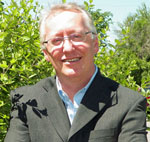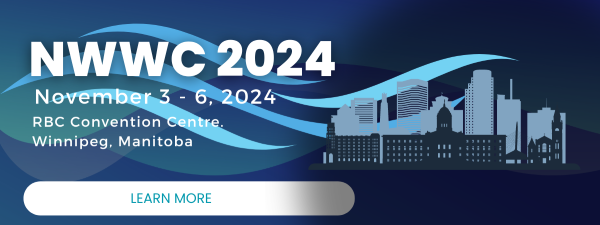 |
||||||||||||||||||||||
| Subscribe | Past Issues | www.cwwa.ca | Water Source Magazine | ||||||||||||||||||||||
|
CWWA News
We can all learn a lot from a disaster, or from any system failure…and it doesn’t have to happen to my town for me to learn valuable lessons. Anyone else’s headache can be an example of what "could" happen to us – allowing us to prevent it, prepare for it, or respond to it. 2024 has certainly provided us with an abundance of disasters and system failures to learn from. We have all been following the watermain break in Calgary, but there have been major breaks across the country causing significant impacts in places like Montreal and Ottawa and Vancouver. A power outage in Edmonton put that city on alert while overwhelming rains flooded Toronto highways and transit systems. The National Water and Wastewater Conference is less than two months away! We have a fantastic technical program lined up with great sessions exploring everything from biosolids management to wastewater treatment and climate change impacts and mitigation. We’re working on finalizing our utility stream which has some great sessions planned. We’ve got sessions highlighting the Water Canada top 50 water projects in Canada, a session hosted by the new Canada Water Agency which will give insight into the Agency’s mandate and initiatives.
ISO TC 224 (https://www.iso.org/committee/299764.html) is one of many ISO (International Standards Organization) Technical Committees (TC). It was established in 2002 and has members from 35 participating countries including Canada. In addition, there are 36 observing country members. This work is incredibly important in forming international benchmarks for water services, and with more support could act as a foundation for the development of canadian standards.
Federal Initiatives
Health Canada has published the final objective for PFAS in drinking water. This objective represents a precautionary group-based approach. The objective value of 30 ng/L (for the sum total of 25 specific PFAS) was established to reduce exposure to PFAS in drinking water. Where PFAS are detected in drinking water, the management of health risks and communication of the issue, as well as treatment options (if required) should be carefully examined with the stakeholders involved while considering the specifics of each situation. CWWA’s Drinking Water Quality Committee reviewed and commented on the document when it was drafted. The Committee also released a fact sheet on PFAS (which is being revised to reflect new information and this objective).
Provincial News
The Manitoba government has introduced the Nutrient Targets Regulation under the Water Protection Act, setting formal nutrient reduction targets for Lake Winnipeg and its tributaries, including the Red, Winnipeg, Saskatchewan, and Dauphin rivers. This initiative aims to improve water quality and combat the rise in nitrogen and phosphorous levels that have led to frequent, potentially toxic algal blooms. The regulation mandates regular reporting on progress and supports nutrient reduction strategies and best management practices. Stakeholders, including the Red River Basin Commission, Manitoba Pork, and the Manitoba Association of Watersheds, have expressed support for the regulation, emphasizing its role in environmental protection efforts and the importance of reliable data. The Canadian government is collaborating with various stakeholders to foster a clean economy in Saskatchewan, recognizing climate change’s impact on the environment and economy. Initiatives include engaging with Indigenous leaders and local communities to explore opportunities in carbon capture, critical minerals, clean fuels, and electricity generation. Saskatchewan is expected to significantly increase clean energy jobs by 2050. Investments are being made in renewable energy, critical mineral processing, low-emissions potash mining, small modular reactor development, and clean energy projects, including those in Indigenous communities. The government is also funding EV chargers and supporting pollution reduction projects. Snippings & Clippings
Inter Press Service Overnight, hundreds of people in the rural community of Las Mangas, located in Granma province in eastern Cuba, realised something they had already suspected: that the water they had been drinking for decades was not exactly crystal clear, but rather “salty”, as they say. Water Canada Yesterday’s water demand was 473 million litres, which is down slightly from 475 million litres yesterday. We are trending in the right direction to keep our treated water consumption down, as we continue making urgent repairs to the Bearspaw South Feeder Main. CBC News About one in every five kilometres of large water mains in Canada is in poor or entirely unknown condition, according to survey data — an unsettling figure following a summer of high-profile infrastructure failures. YaleEnvironment 360 The number of conflicts worldwide involving access to water reached an all-time high in 2023, a new report finds. The Pacific Institute, a think tank, tallied 347 entanglements over water last year, up from 231 the year prior, part of a “disturbing trend,” the report said, “where access to water is regularly becoming a factor in armed conflicts around the world.” Authors said that, increasingly, droughts and floods are straining water systems around the globe, fueling greater conflict. ES&E Magazine A water main break in Montreal burst through the asphalt and gushed water high into the air for more than five hours on the morning of August 16, flooding scores of local homes and businesses just east of downtown. ES&E Magazine A large, critical water pipe that supplies some 20% of the drinking water to the Region of Waterloo is set to shut off for one week while repairs are completed, regional officials announced. CBC News We usually don't think about what happens after we flush our waste, but a team of B.C. researchers is experimenting with ways to convert our sewage into energy. The team has been working both in the lab and at the sprawling 24-acre Lulu Island sewage treatment site in Richmond, B.C., where they've built a high-tech mini sewage digester that they're seeding with naturally-occurring microbial populations that digest the organic matter. Bloomberg Beating the heat in the US is a little harder this summer than it used to be: E. coli and cyanobacteria are causing widespread beach closures at lakes and rivers. It’s a problem exacerbated by climate change-fueled warmer waters and more prolific downpours, which are creating perfect conditions for bacteria to flourish. |
||||||||||||||||||||||










